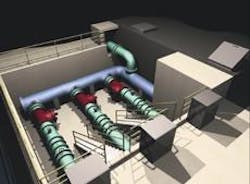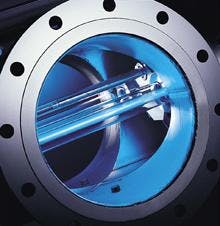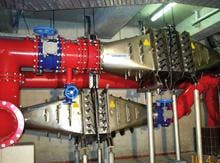UV Disinfection Gaining Acceptance in US Market
By Robert A. Hulsey, Heather E. Mackey,and Jeff J. Neemann
The use of ultraviolet (UV) light to accomplish disinfection has long been established in the North American wastewater industry and is gaining popularity in the treatment of drinking water. While wastewater treatment uses feedback measurement of effluent water quality to determine regulatory compliance, water treatment regulators rely on indirect measurement of disinfection using a concept similar to the calculation of CT values (Concentration multiplied by exposure Time) for chemical inactivation.
With regulations pertaining to Cryptosporidium inactivation looming on the horizon, the U.S. Environmental Protection Agency will soon issue a guidance manual to provide states with direction on the proper installation and operation of UV disinfection systems.
Various communities in the United States and Europe pioneered the application of UV disinfection for municipal water and wastewater treatment in the early 1900s. Early experiments with both UV and ozone appear to have met with difficulties, while chlorine found favor for reasons related to economics and ease of use, becoming the dominant drinking water disinfectant.
Interest in UV has resurged due to its efficacy as a disinfectant, advances in equipment reliability, and Cryptosporidium inactivation requirements as well as restrictions on chlorinated and brominated disinfection byproducts in drinking water. The technology's surge in popularity for potable water treatment is directly attributable to the discovery that radiation in the UV-C range is effective for inactivation of pathogens such as Cryptosporidium and Giardia. This discovery impacted negotiations for the Long Term 2 Enhanced Surface Water Treatment Rule (LT2ESWTR), slated for proposal this summer (2003).
Tool in the Toolbox
The LT2ESWTR will be a product of the regulatory negotiations process. The Agreement in Principle produced by the Federal Advisory Committee as part of the reg-neg process for the LT2ESWTR offers UV disinfection as one of many "tools in a toolbox." In fact, the cost-effective use of ultraviolet disinfection to inactivate Cryptosporidium is a fundamental premise of the agreement.
Whereas the LT1ESWTR established a 2-log removal criterion for Cryptosporidium, the LT2ESWTR will establish further removal/inactivation requirements. Raw water quality will determine which systems must document additional removal efficiencies or provide inactivation. Most systems with inactivation requirements will need to use alternate disinfection techniques because free chlorine and chloramines are largely ineffective against Cryptosporidium.
While the Agreement addressed UV for disinfection of surface water, it was clear that EPA needed to provide basic design criteria by which to determine adequate disinfection before UV could be widely implemented. The agency therefore drafted a guidance manual for UV disinfection in conjunction with the proposed LT2ESWTR. The stakeholder draft of the Ultraviolet Disinfection Guidance Manual was issued for limited review and comment in October 2001. Of the draft manual content, dose values, validation and monitoring requirements, and guidance for a short-term situation in which a UV system doesn't provide the required dose (e.g., during a power interruption), are expected to draw the most interest.
UV Dose
The UV dose required to achieve the desired inactivation of the target pathogen is critical for utilities considering use of UV disinfection under the LT2ESWTR. During the negotiations phase, the dose most often taken under consideration was 40 mJ/cm2. The dose values presented in the table are based on bench-scale tests where precise measurement can be used to calculate the exposure time and the UV fluence rate to calculate the dose.
In large-scale, flow-through reactors, UV dosage can vary greatly with the flow characteristics of the reactor, the placement of the lamps, and the lamps' germicidal output. To account for the variation between the ideal conditions of bench-tests and non-ideal conditions of full-scale applications, EPA is expected to apply a safety factor to the proposed dose values shown in the table (Schmelling, 2002).
Assuming a safety factor of 2 to 3 would be applied to a well designed UV system, these values indicate that a dose of 40 mJ/cm2 would provide 3-log inactivation of Giardia and Cryptosporidium. Much higher doses are required to achieve inactivation of Adenovirus. Final guidance on this issue will be provided in the next draft of the manual, scheduled for distribution this summer.
Validation, Monitoring
With UV, no simple chemical residual measurement can be used to determine if microbes have been inactivated to a sufficient degree. Instead, UV reactors are "validated" to perform under certain conditions of flow, water quality, and UV lamp output. Validation tests would entail seeding the challenge microbe into the UV disinfection unit and measuring the inactivation achieved by the reactor. A UV dose equivalent would be assigned to each system's UV reactor by comparing the inactivation achieved by the reactor to a UV dose-response curve for the challenge microbe using a collimated beam.
Each validated system must monitor operations to demonstrate that the system is being operated within its validated parameters. Monitored parameters are expected to include flow rate, lamp outage, and irradiance as well as water quality parameters. The sensors used to determine irradiance would be used as a check on the reactor's performance. Each system would then report UV reactor operation outside of its validated conditions.
Off-Specification Operation
One of the biggest questions for UV systems is how to handle short-term incidents where the lamp output dims or is reduced below the validated condition. For example, a momentary power "blip" may cause a UV system to shut off power to a lamp. This would require a cooling-down period, a restrike of the arc inside the lamp, and a power-output recovery period. Because water treatment plants don't typically shut down for such short-duration incidents, the time during which water passes through the reactor and the lamp is being brought back up to power could be considered as not meeting the requirement to provide continuous disinfection. These conditions have been described as an "off-specification" period.
One solution is to provide an uninterruptible power supply (UPS) system to carry the UV reactor through these short periods. With power requirements for UV systems on recent bids ranging from 1 to 5 kW/mgd, the costs for a UPS system capable of maintaining operation under all conditions could be significant. The need for a backup system must be balanced with the quality of power supply available at the system site and the utility's ability to meet the requirements of the final guidance manual.
Design Issues
Retrofitting UV disinfection into an existing treatment plant requires consideration of:
• Available head. With pressure-drop varying from 6 to 36 inches, fitting UV reactors into a facility's hydraulic profile is a major issue.
• Power cost. Operating a UV system in an energy-efficient manner is important. This includes being able to reduce UV power usage when water quality is high or flow is low. Transmittance and intensity sensors can help utilities identify such opportunities.
• Space. With most UV disinfection expected to be installed following filtration, available space in existing pipe galleries can be quickly overrun to provide adequate straight runs of pipe for valves, flow meters, and the UV reactor.
• Validation requirements. Systems that validate on site must incorporate flow disposal during testing. Diversion to backwash water storage ponds, NPDES permitted discharge, or sewer connections may be required.
• Redundancy. Existing guidance from the National Water Resources Institute (NWRI) on what type of redundancy is required for an on-line reactor is subject to interpretation. One interpretation requires redundant reactors in series, which significantly impacts system cost.
• Maintenance requirements. Although cleaning maintenance is an issue for some high hard or iron and manganese waters, UV system maintenance shouldn't be a major concern.
Patent
While the use of UV for treatment of surface waters is promising, application of this technology currently requires a fee. The Calgon Carbon Corporation (CCC) holds a patent for the use of UV for preventing replication of Cyptosporidium and has indicated in letters to EPA, AWWA, and others that users must obtain a license before treating water with UV.
The licensing fee for water utilities that use UV has been established at $0.015 per 1,000 gallons treated with continuous-wave UV technology. This fee must be paid regardless of the type of UV equipment or UV vendor that is selected if the system will be used within the dosage range described in the patent. While the patent is being challenged in several court cases, would-be users of UV disinfection should be aware of the potential operating costs if the patent is judged to be valid.
About the Authors: Robert A. Hulsey is Director of Water Treatment Technology and Heather E. Mackey and Jeff J. Neemann are Water Process Engineers in the Americas Division of Black & Veatch. All are members of Proteus, the company's global team of water and wastewater treatment process specialists, and are based in Kansas City, Mo.


